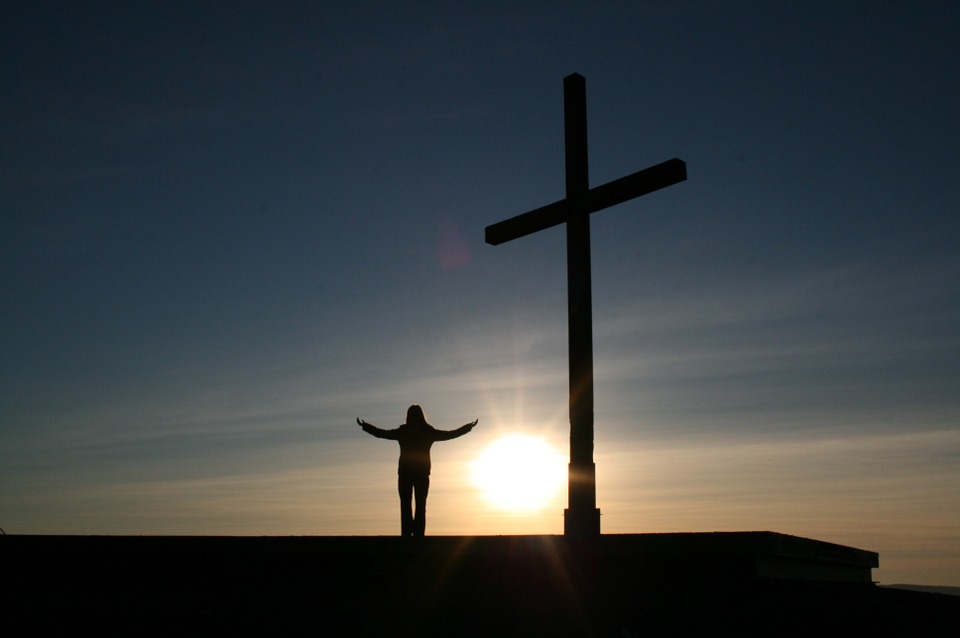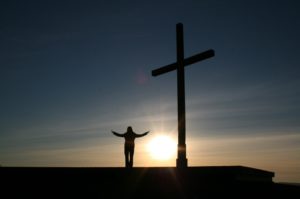When I was young and throughout my seminary years, I usually contemplated the crucifix and Jesus’ suffering on the Cross somberly. It was my sin that had put Him there, that had made Him suffer. The Cross was something that compelled a silent reverence in me, and suggested that I meditate deeply on what Jesus had to endure. I would often think of John, Mary, and the other women beneath the Cross, mournfully beholding Jesus’ slow, painful death.
These were heavy and somber notes, but deeply moving themes.
In addition, the crucifix made me think about the fact that I would have to carry a cross and go through the Fridays of my life. I needed to learn the meaning of sacrifice.
Liturgically, I saw the crucifix as a way of restoring greater reverence in the Mass. Through the 1970s and 1980s, most parishes had removed crucifixes, quite often replacing them with “resurrection crosses,” or just an image of Jesus floating in mid-air. I used to call this image “touchdown Jesus” since it so closely resembled a football referee indicating a score. In those years we had moved away from the understanding of the Mass as a sacrifice; we were more into “meal theology.” The removal of the crucifix from the sanctuary was a powerful indicator of this shift. Many priests and liturgists saw the Cross as too somber a theme for their vision of a new and more welcoming Church, upbeat and positive.
This Cross-less Christianity often led to what I thought was a rather silly, celebratory style of Mass in those years, and I came to see the restoration of the crucifix as necessary to bring back proper balance. I was delighted when, through the mid-1980s and later, the Vatican began insisting in new liturgical norms that a crucifix (not just a cross) be prominent in the sanctuary and visible to all, and further, that the processional cross had to bear the image of the crucified.
Balance Restored – I was (and still am) very happy about these new norms because they restore the proper balance. The Mass is a making-present of the once-for-all, perfect sacrifice of Jesus on the Cross; it is also a sacred meal, whose power comes from that sacrifice. I also believed that such a move would help restore proper solemnity to the Mass, and to some extent that has occurred.
All of this background is just to say that I saw the cross — the crucifix — in somber, serious tones. The theme was meant to instill solemnity and encourage meditation on the awful reality of sin and on our need to repent.
But the Lord wasn’t finished with me yet; He wanted me to see another understanding of the Cross.
He wanted me to also experience the “good” in Good Friday, for the Cross is also a place of victory and love, of God’s faithfulness and our deliverance. There’s a lot to celebrate at the foot of the Cross.
It happened one Sunday during Lent of 1994, one of my first in an African-American Catholic parish. It being Lent, I expected the typically celebratory quality of Mass in the parish to be scaled back a bit. Much to my surprise, though, the opening song began with an upbeat, toe-tapping gospel riff. At first I frowned, but then the choir began to sing:
Down at the Cross where my Savior died,
Down where for cleansing from sin I cried,
There to my heart was the blood applied;
Glory to His name!
Ah, so this was a Lenten theme! It was odd to me to hear the Cross being sung of so joyfully.
This was quite new for me. Perhaps it shouldn’t have been, but it was. The Catholicism of the 1970s and 1980s with which I was familiar found it necessary to remove the cross in order to celebrate, but here was celebration with and in the Cross!
The choir continued,
I am so wondrously saved from sin,
Jesus so sweetly abides within;
There at the Cross where He took me in;
Glory to His name!
The congregation and choir were stepping in time and clapping, rejoicing in the Cross, seeing it in the Resurrection light of its saving power and as a glorious reflection of God’s love for us. Up the aisle the procession wound. The last verse was transposed a half-step up to an even brighter key:
Oh, precious fountain that saves from sin,
I am so glad I have entered in;
There Jesus saves me and keeps me clean;
Glory to His name!
Yes, indeed, glory to His name! A lot of dots were connected for me that day. The Cross indeed was a place of great pain, but also of great love. There was grief, but there was also glory; there was suffering, but there was also victory.
Please do not misunderstand my point. There is a place and time for quiet, somber reflection at the foot of the Cross, but one of the glories of the human person is that we can have more than one feeling at a time, even conflicting ones.
Balance – Some in the Church of the 1970s and 1980s rejected the Cross as too somber a theme, too negative. They wanted to be more upbeat, less focused on sin; and so, out went the Cross. There was no need to do this, and it was an overreaction. At the Cross, the vertical, upward pillar of man’s pride and sin is transected by the horizontal, outstretched arms of God’s love. With strong hand and outstretched arms, the Lord has won the victory for us: there at the Cross where he took me in, glory to his name!
The balance is both for the individual and for the Church. Some prefer a more somber meditation on the Cross to prevail, while others feel moved by the Spirit to celebrate joyfully at the foot of the Cross. The Church needs both. I suppose we all need some of both experiences. Yes, it is right to weep at the Cross, to behold the awful reality of sin, to remember Christ’s sacrifice; but we should rejoice, too, for the Lord has won the victory for us, right there: Down at the Cross. There’s a lot of good in Good Friday.
Here is the song I heard that Sunday in 1994, sung in very much the style I remember.


